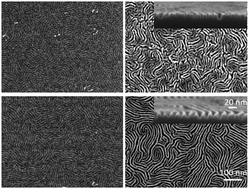Enhanced microphase separation of thin films of low molecular weight block copolymer by the addition of an ionic liquid†
Abstract
We report on the use of a selective, non-volatile ionic liquid (IL) to enhance the self-assembly via solvent annealing of a low molecular weight block copolymer (BCP) of styrene and 2-vinylpyridine (2VP) suitable for generating sub-10 nm features. Diblock and triblock copolymers of different molecular weights of styrene and 2VP are individually blended with the IL and then solvent annealed in acetone, a non-preferential solvent for the BCPs. Differential scanning calorimetry indicates that the IL selectively resides in the 2VP block of the BCP, resulting in a decrease of the block's Tg and an increase of the effective Flory–Huggins parameter (χeff) of the BCP. The influence of the IL on the non-preferential window of a random copolymer brush used to treat the substrate for self-assembly of the BCPs is also analyzed. Well-defined lamellar patterns form when the optimal weight ratio of IL (∼1%) is added to the BCPs. A detailed analysis of the orientational correlation length and pitch size of the BCPs quantitatively shows that the addition of the IL enhanced the microphase separation of the low molecular weight version of the BCP. Subsequent treatment of the self-assembled BCP with sequential infiltration synthesis yields sub-10 nm AlOx lines.



 Please wait while we load your content...
Please wait while we load your content...